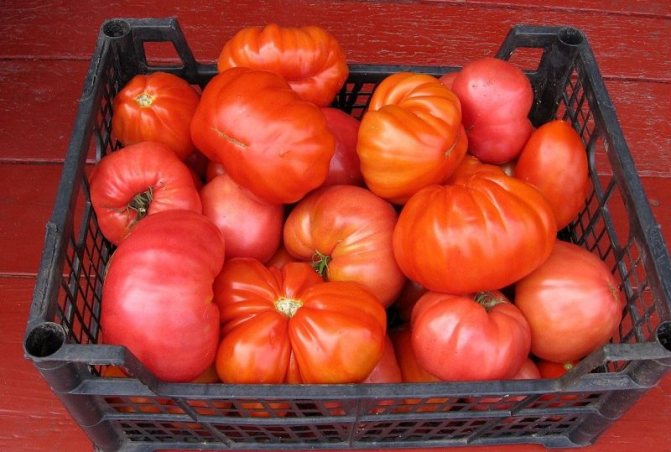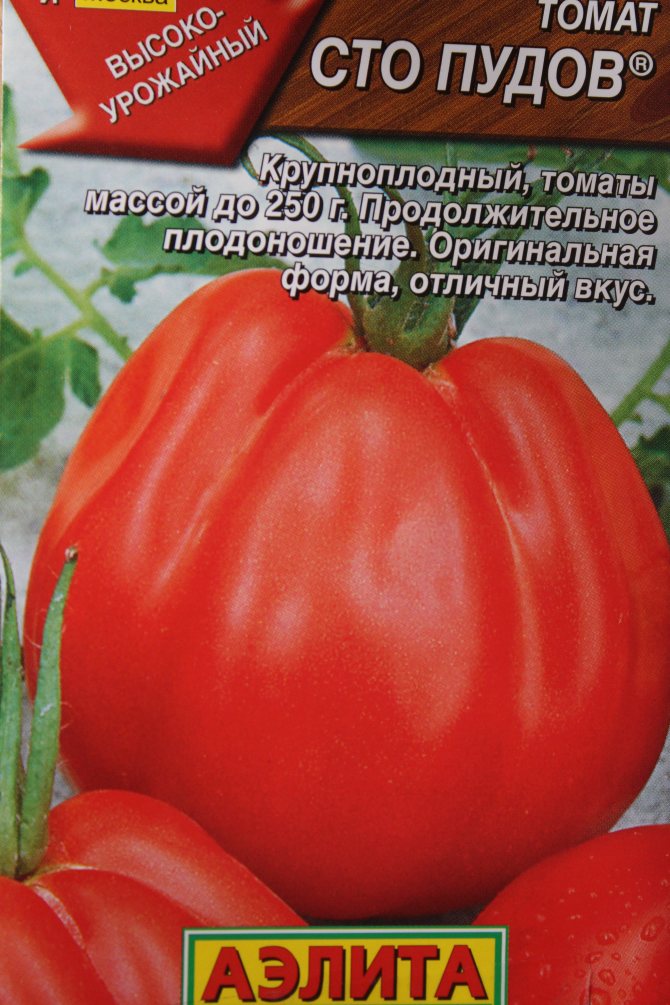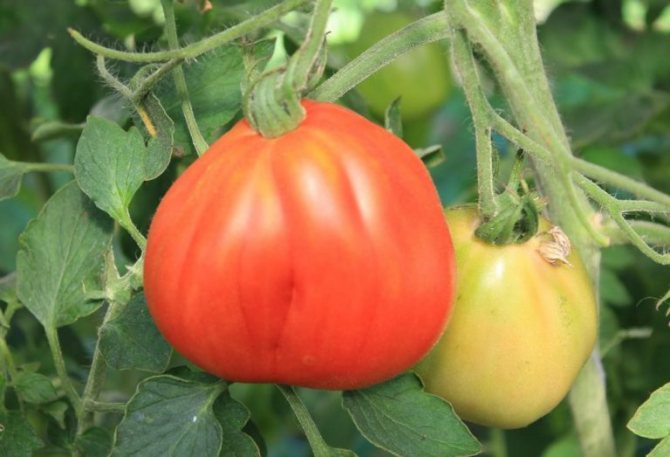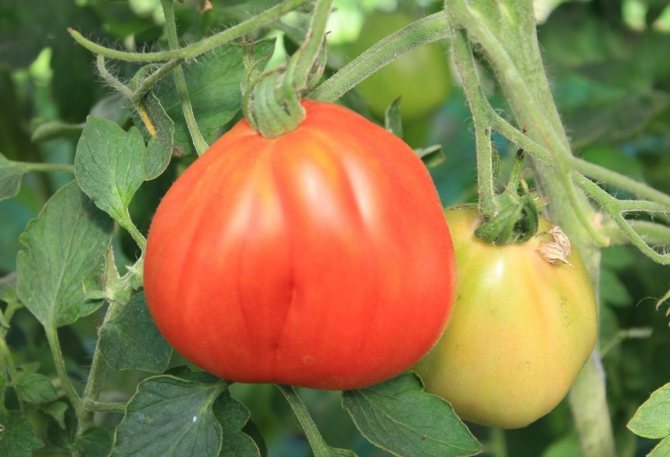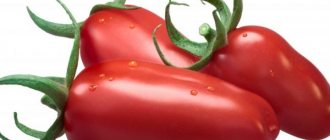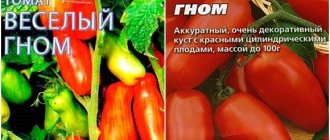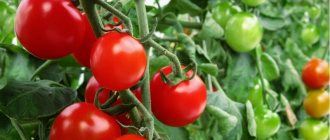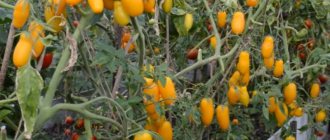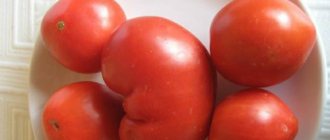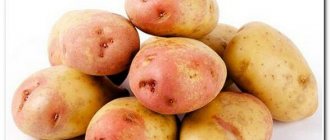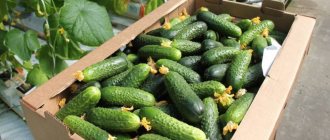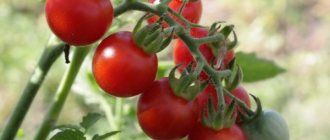»Vegetable growing» Tomatoes »Tomato variety One hundred pounds
0
202
Article rating
A garden innovation of the Moscow region agro, a tomato One hundred pounds, registered in the State Register in 2013. The unusual name is associated with the main advantage of the variety: the tomatoes are quite massive and have many positive qualities.
Tomato variety One hundred pounds
Fruit characteristics
- Fruits are round-pear-shaped, strongly ribbed at the stalk, bright red in color.
- Large, each weighs about 170-300 g. The color of ripe fruits is red.
- The pulp is juicy, fleshy.
- Inside 4-6 seed chambers with few seeds.
- The skin is dense, but thin, does not crack.
- The taste is delicious, sweet with a slight sourness.
- Contains a lot of lycopene, sugars and beta-carotene.
Tomato "One hundred pounds" characteristic and description of the variety is impossible without praise of the tomato itself.
This variety gives us large and very large fruits. If the numbers 180 - 250 g appear in agronomic reference books, then many amateurs, describing these tomatoes, call the numbers 250 - 350. However, the variety is famous not so much for its size as for its taste.
The fruit is fleshy, dense, elastic. In an unripe form, it has a rather light green color, but a ripe fruit is deep red, although sometimes amateurs claim that it has orange tones.
The skin on the tomato is smooth and firm, but can be removed without boiling water, which is very convenient for consumption.
In shape, the fruits are pear-shaped with ribbing, but otzoviki describe them more as "huge ribbed pears". Indeed, the unusual shape and ribbing attracts the attention of both adults and children, and lovers of exotic do not bypass these fruits on the market, not even knowing about its taste.
A nice bonus of this tomato is that at the point of articulation with the stalk, it does not have a green spot at all. Stem greens do not penetrate the tomato fruit and when cut, it beckons with its ripeness and fleshiness.
It might be interesting
The seed chambers are quite clearly expressed and when cut across they can be counted up to a dozen. They are not symmetrical, which is typical for ribbed tomatoes. However, the seeds in them are not in liquid fruit waters, but in a thick "syrup".
A feature of the variety is the fact that the fruit, having a fairly large size, does not contain a large number of seeds.
Tomatoes of this variety have the peculiarity of slow, gradual, but uniform ripening over the entire surface of a huge tomato.
Characteristics
The “Hundred Pounds” tomato variety was bred by Russian breeders. Suitable for different regions for growing in glass greenhouses and film shelters. In areas with a warm climate, planting in beds is possible. To the characteristics of the tomato "One Hundred Pounds" it should be added that the yield is good, up to 6 kg of selected tomatoes can be harvested from 1 bush... The fruits are well stored, transportation is possible. Picked green tomatoes ripen quickly at room temperature.
The variety is universal, the fruits can be eaten fresh, used for cooking various dishes, canned. Ripe tomatoes make a delicious thick juice.
As for the yield of other varieties, you will find this information in the table:
| Variety name | Yield |
| One hundred pounds | 6 kg per bush |
| Banana red | 3 kg per square meter |
| Nastenka | 10-12 kg per square meter |
| Olya la | 20-22 kg per square meter |
| Dubrava | 2 kg per bush |
| Countryman | 18 kg per square meter |
| Golden jubilee | 15-20 kg per square meter |
| Pink spam | 20-25 kg per square meter |
| Diva | 8 kg per bush |
| Yamal | 9-17 kg per square meter |
| Golden heart | 7 kg per square meter |
Advantages and disadvantages
Pros:
- unusual shape;
- high productivity;
- tolerance for lack of light;
- genetic resistance to major diseases.
Minuses:
- it is necessary to form a bush;
- strong support is required;
- weighty fruits need a separate garter;
- does not mature early;
- you cannot collect your own seeds.
There are a lot of salad varieties, more than a thousand, and up to half of them are characterized by excellent fruit taste. Therefore, it is necessary to understand why the variety of One Hundred Pounds attracted enthusiasts-gardeners with a rather ordinary taste. Probably, first of all, an exotic form of tomatoes. Among the advantages of the variety are:
- uncomplicated, for a determinant variety, care;
- pretty good yield;
- large-fruited;
- the ability to ripen in apartment conditions;
- relative shade tolerance;
- normal tolerance of sharp temperature fluctuations;
- increased content of nutrients in fruits.
Among the shortcomings, the need for formation and tying is noted (although what a drawback this is, this applies to more than half of the varieties), as well as imperfect taste. Let's leave the unusual shape of the fruit outside the brackets: after all, it is not always easy to wash corrugated vegetables, and aesthetic problems may arise when cutting. Rather, this variety is for lovers of experimentation, and even exotic.
Among the many varieties of salad, one hundred pounds, of course, cannot be attributed to the best. You can compare it with similar ones in shape. There are already a little less than a hundred tomatoes with pear-shaped fruits, and among them there are very few that are "heard". Although, of course, there are quite good ones. For example, a red pear tomato has almost the same yield as one hundred pounds, although its fruits are several times smaller.
But they taste great and are suitable for any purpose. The new variety Miracle Wonderful, registered in 2020, is also characterized by an excellent taste of tomatoes with a mass of about 200 g. In shape, it even resembles the variety in question, but the ribs are less pronounced, and the color of the fruits is yellow.
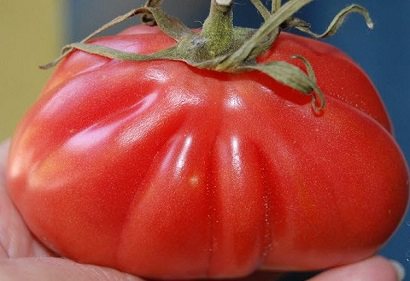
The late-ripening variety Veselyy Neighbor has a strong ribbing. Its fruits are even larger than those of a Hundred Pounds, but their shape is flat-round, and the taste is good. Approximately the same characteristics of the Novosibirsk variety Gribnoe basket. Considering the properties of highly ribbed tomatoes, it should be noted that most of them do not shine with taste;
Among the positive features of the variety are:
- Great taste.
- High productivity.
- Unpretentious care.
- Resistance to diseases and temperature extremes.
- Long-term fruiting.
Among the disadvantages are the following:
- The need to form and tie a bush.
From the described characteristics it can be seen that “One Hundred Pounds” is a real find for farmers, as it meets all the necessary parameters of marketability. It is worth highlighting the following advantages of the variety:
- high tasting qualities;
- by the number of useful elements, the variety can be attributed to dietary products;
- high yield even if the rules of agricultural technology are not followed;
- good transportability, marketability, the possibility of ripening;
- resistance to major diseases of tomatoes;
- tolerates drought and sudden changes in temperature.
But there are also disadvantages, determined by the intent. First of all, this is the need to form a bush of 1-2 stems with constant pinching. Due to the growth of the plant, the stems require regular tying. Support is also necessary for the hands themselves, on which an impressive weight is collected.
The main advantages of the variety:
- excellent dessert taste, very healthy;
- high yield;
- tomatoes are stored for a long time, have an excellent presentation;
- transportable;
- unpretentious in care;
- well tolerates sudden changes in temperature, drought;
- has immunity to major diseases.
The disadvantages include the need to form a bush. Tall plants need strong support, you need to tie up not only the stems, but also heavy branches with fruits.
Characteristics of the tomato variety One hundred pounds
In order to make a decision on growing a tomato on your site, it is not enough to focus only on the appearance and size of the fruit. The characteristics and description of the 100 pood tomato variety should be studied as carefully as possible.
Tomato yield One hundred pounds
Tomatoes 100 poods can please gardeners with very good harvests. In each cluster, up to 5 tomatoes are formed on the stems, and one bush can bear 5 - 6 kg of fruits. Thus, the volume of the harvest depends on the size of the plantings - from 1 sq. m. you can collect up to 9 kg of juicy tomatoes. Traditionally, in greenhouses, the yield of the variety is slightly higher, and in the open air it is slightly less.
Scope of the fruit
Description of tomatoes One hundred pounds says that the fruits belong to the category of universal - you can use them freely at your discretion. The tomatoes taste sweet, with a slight sourness, juicy and dense. Ideal for salads and vegetable appetizers, they can be boiled and sautéed to add to soups and main courses.
Theoretically, fruits of 100 pounds are suitable for conservation - the dense skin of tomatoes does not crack. However, banks will need large ones, since the fruits themselves are quite large.
Disease and pest resistance
Diseases and pests affect the 100 poods variety quite rarely. But insects and fungal ailments can still spread to tomatoes from the soil or other plants, so high-quality prevention is very important. In particular, it is recommended:
- before planting tomatoes 100 poods in the ground, disinfect the ground by spilling it with a solution of copper sulfate;
- ventilate the greenhouse for a short time every day if tomatoes are grown in a greenhouse;
- timely apply mineral fertilizing;
- regularly inspect leaves, stems and fruits for suspicious spots and insects;
- spray tomatoes with Phytosporin or Bitoxibacillin to avoid fungal growth.
Advice! both purchased insecticides and homemade homemade remedies - decoctions of celandine and birch tar, soap solution - help well against pests.
Advantages and disadvantages of the variety
The popularity of Hundred Pounds is explained by the fact that the variety has many advantages. Namely:
- grows successfully both in greenhouse conditions and in the open air;
- requires minimal maintenance and has a strong immunity to pests and fungal diseases;
- gives bountiful harvests from large, aromatic and tasty fruits;
- ripens quickly - with a normal spring planting, you can taste ripe tomatoes in a couple of months, in the middle of summer;
- brings tomatoes suitable for all types of culinary processing;
- ripens already during storage, without losing its freshness and taste at all.
As for the shortcomings, there are few of them, and they are all insignificant. In particular, the 100 pounds variety needs to be tied up with tomato stems, and is not always suitable for canning - its fruits are too large.
Sowing seeds
Seeds are sown for seedlings in the third decade of March. Before sowing, put the seeds in a bag of gauze and immerse them in a pink solution of potassium permanganate for a quarter of an hour. Next, put 2 drops of Zircon in 100 ml of water and lower the seeds for 6 hours.
Make soil by mixing garden soil with humus, peat, add a little superphosphate, ash. Calcine the soil for 20 minutes in the oven at a temperature of 200 degrees.
When planting, deepen the seeds by 1 cm, water the plantings from a spray bottle, cover with foil, put in a warm room.
When shoots appear, remove the film, put the shoots on the windowsill. Water with a spray bottle or watering can. When 2 true leaves grow, dive seedlings. Then fertilize with a solution of complex mineral fertilizer.
When to plant seedlings in the greenhouse? When the seedlings are 2 months old, transplant them into a greenhouse. Seedlings are planted in the place where cucumbers, legumes, cabbage, onions, carrots grew before.
Fertilizer features
Top dressing is performed according to the following scheme:
- The first time they feed the soil when planting plants in boxes. A mixture of turf, peat, sawdust and humus in equal parts is taken as a soil.
- Fertilize again after diving the seedlings. In 10 liters of warm water, dissolve 3 tablespoons of mullein, half a teaspoon of copper sulfate.
- 15 days after dissection, fertilize for the third time. A spoon of nitrophoska and a glass of mullein are stirred in 10 liters of water.
- After 20 days after dissection, the plants are planted in more spacious containers and after 10 days they are fertilized for the fourth time. A spoonful of double superphosphate and two tablespoons of ash are stirred in 10 liters of water.
- The fifth feeding will depend on the nuances of growth. If the plantings are stretched, it is watered with a urea solution. If the development of seedlings is too rapid, they are watered with dissolved superphosphate.
- The sixth stage of fertilization corresponds to the preparation of the soil for planting plants. If the soil is clay or loam, then a bucket of peat, sawdust and humus is added for each meter. A bucket of turf, sawdust and half a bucket of sand are added to peat soils. If you need to lower the acidity of the soil, you need 3 glasses of ash or 2 glasses of dolomite flour for each square meter. Then watered with a solution of mullein in the amount of one liter of manure per 10 liters of water.
Read also: Tomato Empire - description and characteristics of the variety
Weak plants are fed foliarly. At the same time, foliage is sprayed. A solution with a spoonful of urea in 10 liters of water is suitable. Such spraying is repeated as needed after two weeks.
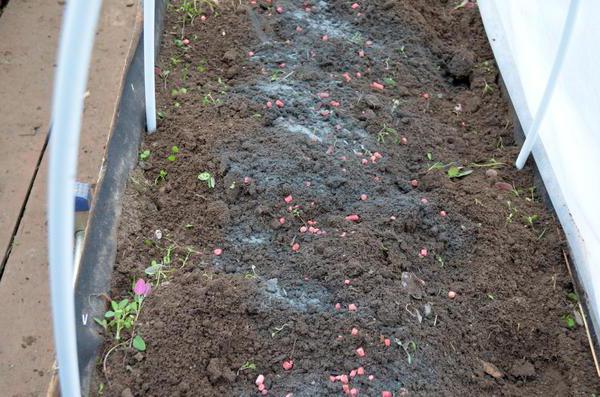

Features of growing and care
The variety has already managed to attract summer residents with its unpretentiousness. But this does not mean that tomatoes do not need to be paid attention. And you should start, as always, with the preparatory moments.
Seed preparation
The purchased planting material has already passed the necessary processing. If the seeds were collected with their own hands (or purchased from friends), it is recommended to hold them for 20-25 minutes in pink potassium permanganate. Do not forget to pack in a canvas bag. Then they are transferred into a solution of "Zircon" (2 drops per 100 ml of water) and kept there for 6 hours.
The soil mixture is prepared from garden soil with the addition of peat and humus. Fertilizers are immediately applied - wood ash and superphosphate. Before sowing tomatoes, it is recommended to hold the soil for 20 minutes in the oven (200 °).
Having made grooves in the seedling box to a depth of 1 cm, carefully spread the processed seeds. After sprinkling with a spray bottle, sprinkle with earth, and cover the box with foil. The container is installed in a warm room away from the window.
Growing seedlings
As soon as the seedlings hatch on the surface, the film must be removed and the box rearranged to the light. In the phase of 2 true leaves, a pick is carried out. Seedling care consists in irrigation from a spray bottle and the introduction of complex mineral water 10 days after the pick.
Transfer
The sprouts are transferred to a permanent place 2 months after sowing. But if we are talking about open beds, then the climatic features of the region are taken into account. It is recommended to sow tomatoes "One hundred pounds" in the first half of March. Therefore, they should go to the garden by mid-May. For example, in Central Russia during this period there is a risk of recurrent frosts.
Before sending the seedlings to the garden, the plot is divided in such a way that there are 3-4 bushes per 1 square meter. A peg is driven into the hole under each of them - a sprout will be tied to it when planting. But here the trellis should also be installed in advance.
Further care
Variety "One hundred pounds" does not require frequent watering. If the bushes are grown in a greenhouse, it is enough to add water to the soil once a week, pouring a liter of water under each plant. In open beds, the frequency of irrigation is commensurate with the air temperature. The procedure is carried out in the evening using heated water.
After each watering, the beds are loosened. Weeds and dry foliage are removed as needed. It is necessary to periodically cut off the lower plates (especially during the fruiting period) - this stimulates high yields.
Attention should be paid to top dressing, which is carried out several times during the growing season.
Tomato seeds can be marketed processed. If there is no information about this on the package, you need to pickle the grains yourself.
The soil is spilled with a solution of potassium permanganate, and the seeds are soaked in a 1% solution of copper sulfate for 20-30 minutes. The disinfected seeds are carefully laid out in the grooves of the planting box, leaving a distance of 2-3 cm between them.
Hybrid tomato seeds come in best at 20-22 degrees.
The sprouts that appear on the surface of the soil are exposed to light and are briefly kept at a temperature of 14-16 degrees. During the week of cold keeping, the seedlings have time to grow powerful roots, which then contribute to the good development of the seedlings.
Plants kept in coolness are moved to a warm room and then kept at a temperature above 20. When two leaves appear on them, a pick is made into separate cups or peat tablets.
Tomato seedlings of 100 pounds have time to grow a lot of leaves and develop a powerful root system, so you need to provide enough space to place it on the windowsill.
By the time of transplantation, at least 9 leaves and at least one flower cluster should appear on the plants. Seedlings in open ground or in a greenhouse are immediately tied up, setting the trellis in advance. A handful of humus and a teaspoon of superphosphate are added to each hole.
Plants are watered only with warm water, making sure that moisture does not get on the leaves and fruits.
3-4 feeding is required per season. 2 weeks after transplanting, the garden bed is watered with a urea solution (tbsp. L / 10 l / sq. M.
Mid / Tall
User score: 5/5
Early maturing / Tall
User score: 4/5
Mid / Tall
Water the tomato bushes 100 pounds in the evening with warm, well-settled water, as the tomatoes grow slower from cold water. Pour 1 liter of water under each bush. Water the tomatoes once a week, loosen the ground after watering. Pick off weeds and dry leaves.
Feed 3-4 times per season. Apply nitrogen before blooming. You can feed the tomatoes by adding st. a spoonful of ash in 1 liter of rainwater. Pour half a liter of ash water under one plant, being careful not to get on the foliage.
With the formation of buds, you can fertilize the bushes with humus, having previously watered them abundantly with water. Pour 1 bucket of humus on 1 m² of land, pouring it in a layer of 2 cm, and immediately after the humus, feed the bushes with a solution, pouring 10 g of Baikal into a ten-liter bucket of settled water, then pour the solution over the humus.
Instead of humus, you can make such a top dressing: pour 1 - 2 kg of bird droppings into a ten-liter bucket of rainwater. Leave it on for a week. Then dilute the fertilizer with more water at a ratio of 1:20.Pour the liquid top dressing under the root until flowering, half a liter per bush. This is a fairly intense nitrogen fertilizer.
After setting the fruits, feed the bushes with magnesium sulfate or superphosphate.
Leave 1 - 2 stems, pluck the rest. Be sure to remove stepsons. Tear off 2 to 3 bottom sheets every 10 days. To make the tomatoes large, pluck the flowers, leaving 3 - 4 on each brush.
Tomato growing rules
One hundred pounds is not a hybrid; the collected seeds sprout. The tomato is unpretentious to the type of soil, it bears fruit well both in the greenhouse and in the garden.


When to plant seedlings
Tomatoes are moved to a permanent place when a sharp cold snap is no longer expected. Tomato seeds are sown no later than 2 months, but no earlier than 45 days before planting in closed ground or on a garden bed. It is easy for a summer resident or gardener to calculate the optimal time.
Selection, preparation and sowing of seeds
Tomatoes, fully ripe on the bush, are cut and placed in a jar of water. After two days in the warmth, they begin to ferment, the surface of the container is covered with a whitish film, and small grains are easier to extract. The seeds are washed, dried and folded into a paper bag.
Before planting the seed:
- Warm up at 45-60 ° C.
- Soak in salt water.
- The floating grains are removed, the rest are disinfected in potassium permanganate.
To improve germination, growth stimulants are used. The seeds are dipped into the solution for at least 12 hours.
Growing seedlings
A loose substrate consisting of turf, sand, peat or humus is poured into the box. The seed is placed at a distance of up to 20 mm from each other, covered with soil, watered well, and create a greenhouse effect with the help of a film.
When seedlings appear, the seedlings are provided with additional lighting and a temperature not higher than 23 ° C. When 4 leaves are formed on the seedlings, the bushes dive into separate pots.
Transfer to the beds
Tomatoes, which will grow outdoors, are hardened in the fresh air at the age of 40–45 days. After 2 weeks, holes are dug on a site fertilized with humus and ash from autumn.
Tomatoes are planted in a checkerboard pattern, 3 bushes are placed on a square meter of land, 0.7 m is left between the rows.
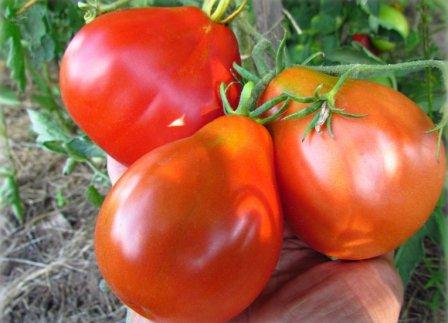

Description of the variety according to reviews of vegetable growers
Further, you can study the reviews of gardeners who have already managed to grow a recently registered variety of tomatoes One hundred pounds on their plots and left their opinions about it.
Violeta Sergeevna, Chelyabinsk region
Irina Vasilievna, Chelyabinsk region
Alla Antonovna, Khabarovsk Territory
Irina Vitalievna, Volgograd region
Galina Mikhailovna, Voronezh region
Tatiana Ivanovna, Saratov region
Svetlana Eduardovna, Bryansk region
Svetlana Mironovna, Moscow region
Tomato One hundred pounds is a good salad variety, but it is not very common due to the unusual shape of tomatoes. Lovers of originality plant it in their plots, but are usually limited to only a few bushes.
Tomatoes "One Hundred Pounds" are a real find both for summer residents and for the farming business. The variety has all the virtues that farmers dream of. And those disadvantages that are present during cultivation can be called relative, because the need to form a bush and tie it up contributes to a high yield.
Those gardeners who grow a “One hundred pounds” tomato in the southern regions unanimously declare that it is of an average ripening period, as shown in the register of varieties. In more northern regions, in the open field, the tomato sometimes does not ripen and it has to be harvested in milk ripeness, although this does not affect the taste. But the greenhouse came in handy, there the tomato showed all its power.
Wherever the variety is grown, the growth of its lashes varies from 1.5 to 2.5 meters. The plant is tall, indeterminate, powerful.How could it be otherwise? A small bush cannot hold on to a large harvest of large fruits.
The plant needs good support, garters and timely formation into one stem. If the soil fertility is high, then the formation in two stems is permissible.
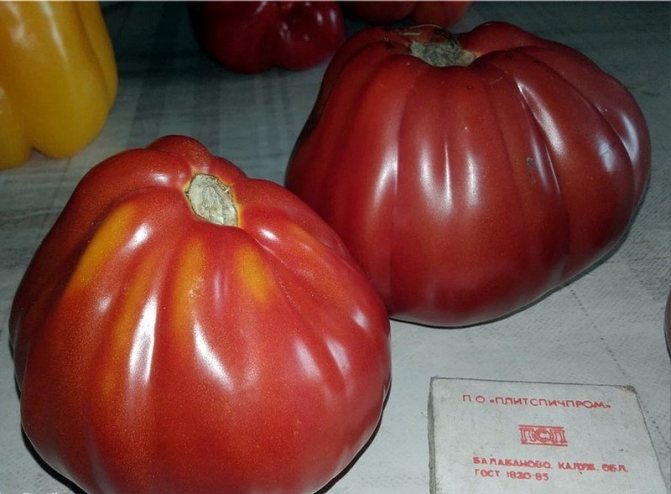

The leaf on these tomatoes is large, rich green and is an excellent accompaniment to excellent tomatoes.
Tomato care
It is necessary to care for the variety One hundred pounds, given that the tomato belongs to the indeterminate type and requires growth regulation.
Watering and feeding
Moistening the soil under the tomatoes planted in a greenhouse or in a garden bed is enough once a week, when the top layer dries up. The water is defended and, if possible, warmed up in the sun. Tomatoes are fed:
- 2 weeks after planting;
- during the appearance of flowers,
- during the formation of the ovary;
- before fruit ripening.
See also
Description of the medicinal variety of tomato Duckling, growing plants in open ground and in greenhouses
To read
Chicken manure, mullein or mineral components in the form of superphosphate, magnesium sulfate are used as fertilizers. Top dressing is combined with watering, loosening the soil, hilling the plant.
Bush formation
When buds appear on tomatoes, the upper flowers are plucked, leaving up to 4 pieces, which helps to collect larger fruits. The lateral shoots 5 cm long begin to be removed as soon as the tomato takes root after transplantation. On the bushes, the lower leaves are cut off, they are formed into 2 stems.
The shoots of the plant are attached to the frame. Supports are placed under the brushes on which the tomatoes are tied.
Disease and pest control
Although the variety Hundred pounds is immune to infection, it is not afraid of mosaic and cladosporium disease, but attracts various insects. To prevent the development of diseases and damage by pests, tomatoes are not planted after eggplants and potatoes, they are sprayed with Fitosporin, Bordeaux liquid or potassium permanganate solution.
When growing tomatoes in a greenhouse, the top layer is replaced with fresh soil every season. If parasites do appear, the bushes are treated with ash, celandine infusions, and onion husks. Long before the fruits ripen, insecticides "Fitoverm", "Akarin" are used.


Diseases and pests: prevention and control methods
The variety is resistant to disease, but requires careful preventive measures. Before planting, the soil is disinfected with a solution of potassium permanganate or copper sulfate. The greenhouse must be thoroughly ventilated, the soil under the bushes is loosened at least 1 time per week. Weeds and dried leaves are removed in a timely manner. Spraying plantings with phytosporin or a pale pink solution of potassium permanganate is protected from fungal diseases.
Insecticides or folk remedies will help get rid of insect pests: celandine broth, warm soapy water, ammonia. Larvae and adult insects are collected by hand and destroyed.
After looking at the photo, description of the "One Hundred Pounds" tomato variety, we can say that it is worthy of a place in a greenhouse or greenhouse. You can try to grow it in the garden, covering it with a film. Tall bushes are productive, seeds for the next plantings are easy to collect on your own.
If you find an error, please select a piece of text and press Ctrl Enter.
The cultivated variety is resistant to disease, but preventive measures must be taken. Spill the soil with a solution of copper sulfate before planting seedlings. Change the topsoil in the greenhouse completely every year. Ventilate the greenhouse every day. Spray plantings with phytosporin to prevent fungal diseases.
If the bushes are attacked by parasites, use insecticides or wash the bushes with warm water with soap, ammonia, celandine infusion.
Pour 200 g of dried celandine in 5 liters of hot water, leave for 2 days, then spray the bushes. You can spray the bushes with the biological product Bitoxibacillin, adding 35 ml to 5 liters of water.
Care
Plants will need 3-4 feeding per season.Nitrogen fertilizers are enough at first. After active growth begins, magnesium sulfate is needed, and then superphosphates.
To ensure high yields, it is important to form the crown on time and remove excess shoots and stepchildren. So that the fruits are not crushed, it is important to leave no more than 3-4 flowers on the brush, removing those that are smaller, affected or deformed.
The variety is quite resistant and not susceptible to disease. But before planting, you need to disinfect the soil with potassium permanganate or a solution of copper sulfate and regularly, at least once a week, loosen the soil.
Description of the variety One hundred pounds, its characteristics, growing region
Tomato One hundred pounds was registered in the State Register of Breeding Achievements of the Russian Federation in 2013 at the request of the well-known, in recent years, producing many varieties of various vegetables of good, mainly, quality. So, in 2020, up to half of the best registered varieties (and there were more than two hundred of them) came out of the hands of this organization. At the same time, one hundred poods celebrated his five-year anniversary: a period that is quite sufficient for the gardeners to have an impression of him.


Characteristics of the tomato variety One hundred pounds according to the State Register
Overall, the impression is good. Like most modern tomatoes, one hundred pounds was developed for small farms, it is recommended to plant it both in greenhouses and in unprotected soil in any region. In the central regions and to the north, this variety is grown mainly "under the roof", and to the south - in the open field. Like most varieties now being created, it is intended mainly for fresh consumption.
The tomato is one of the indeterminate, has thick stems, grows up to two meters in greenhouses and a little less outside them. Requires the obligatory formation of bushes and tying up shoots. Leaves are dark green, large, relatively few of them. The flower cluster consists of 6–7 flowers, of which 4–5 set fruit.
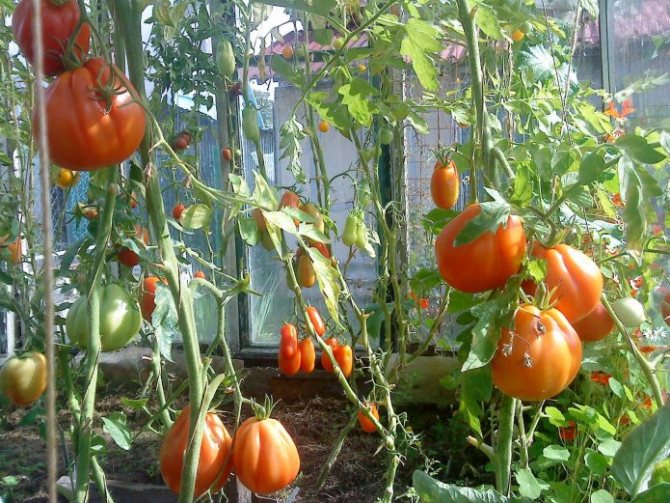

The bushes are tall, and the stems are not very strong, so they must be tied up thoroughly.
In terms of ripening, the variety belongs to the mid-season. The first tomatoes ripen four months after germination, fruiting continues until frost. Fruits of an interesting shape. Not only are they large and look like a pear, this pear, in turn, resembles an accordion: so much, most often, their ribbing is expressed.
The pulp of tomatoes is juicy, fleshy, sugary, slightly sour. The taste is assessed as good, the aroma is strong. The skin is thin, but strong: cracking is not typical for the variety. When grown in open beds in cool regions, tomatoes may not have time to ripen, but when collected brown, they are successfully ripened during storage.
The yield, for a tall plant, is not too high: in greenhouses, according to state tests, up to 9 kg are harvested per square meter of plantings. However, some hobbyists claim that with intensive care, the yield can be almost doubled. Resistance to most diseases is above average.
Description and characteristics of the variety
One hundred poods is a hybrid. It can be cultivated outdoors and under plastic. Despite its hybrid origin, the variety is not recommended for industrial use, but it is perfectly suited for personal subsidiary plots.
Fruits for salad purposes, mid-ripening. The shape is pear-shaped with strongly pronounced ribs, the pulp density is average. When ripe, the tomatoes are red, beautiful, with a glossy sheen. There are 4-6 chambers in the wide part of the fruit. Average weight 200 g, maximum 250 g. Good taste.
Bushes are tall, indeterminate, and require garters and shaping. Tomato reaches a height of 1.6-1.8 m in greenhouses. The leaves are large, dark. The inflorescences are intermediate, that is, the fruits are not in two rows, but more randomly. On average, 2-3 fruits are tied on the hand.
Origin and application
Tomato Hundred pounds brought agro in 2012. The next year, he was included in the State Register and recommended for cultivation in all regions.
The fruits can be used for cooking and preservation. They are processed into delicious and thick tomato juice. Fresh ripe, sugary tomatoes on a break will become a summer table decoration.
Appearance
The appearance of a hundred pounds of tomatoes is very unusual, we can only say that their shape is irregular. It is compared to both a drop and a pear, but this drop is rather big. At the same time, in the upper part of this pear drop, pronounced ribs-folds are observed, uncommon for tomatoes: among the thousands of known varieties, only a few have a similar shape.
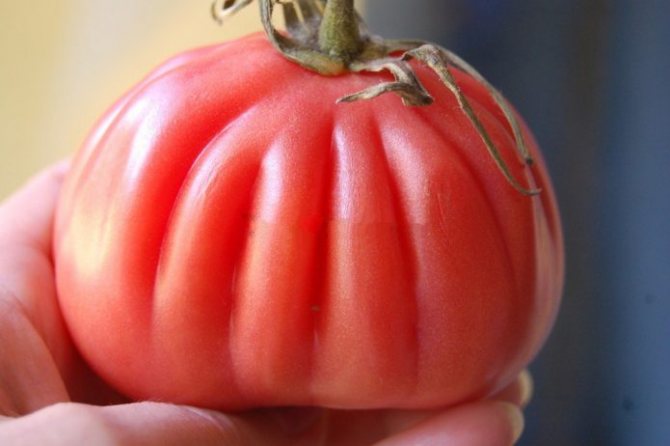

The tomato is large, of the usual color, but not quite traditional in shape
Testimonials


The variety Hundred pounds appeared on the seed market not so long ago, but our amateur vegetable growers have already tried it in business. Reviews of those who planted, note the originality of the shape of the fruit, meatiness and excellent taste, good yield in greenhouse conditions.
Zhanna, 41 years old: “I love ribbed tomatoes, so when I saw Puzata Khata and One Hundred Pounds varieties on sale, I bought them and planted them right away. I liked both varieties for their sweet taste, especially when salted. Puzata khata begins to ripen a little earlier, but one hundred poods is larger. They are similar, but I can't decide yet and choose one, I will grow both varieties. One hundred poods in a greenhouse are more productive than on the street. "
Natalia, 57 years old: “The first year tomatoes A hundred pounds grew in my house without a greenhouse, I ran them a little and did not stepchild. The bushes were big, there were a lot of tomatoes, but all were small. Their shape was so funny that the next year I planted them again, but now I was mercilessly stalking, leaving only one stem. As a result, the first fruits grew by 300-400 grams ”.
Yield
The mid-early variety is suitable for growing in open beds only in warm regions. Starting from the Central zone of Russia, seedlings are formed in heated greenhouses. In the northern regions of the country, due to its indeterminacy, the variety is fully grown in cultivation facilities, which allows you to have fresh tomatoes all year round.
Tomatoes "One Hundred Pounds" are high-yielding. Therefore, regardless of the growing conditions, about 6 kg of fruit can be taken from one bush, and up to 9 kg from 1 square meter.
Having planted and grown the tomato variety "One Hundred Pounds", the reviews of vegetable growers about its yield are very diverse. Someone, impressed by the huge and tasty fruits, rejoices with delight, while someone, realistically evaluating and weighing each tomato, speaks of an average harvest.
The main advantages of this variety are taste and fruitfulness. But he shows the yield at the level of 8 - 9 kg per sq. m., which is not something special, given that modern breeding hybrids show a yield of up to 30 kg per sq. m.
On state variety trials with standard agricultural technology in film shelters, up to 9 kg were removed from 1 sq. m. In amateur conditions, with intensive care, each plant is capable of producing 6 kg of fruit, which, with a scheme of 3 bush per 1 sq. m. allows you to remove 18-20 kg per unit area.
Agrotechnics
Tomatoes One hundred pounds is best grown through seedlings. Sowing is carried out 2 months before the intended landing. Before sowing, home-harvested seeds are disinfected in a solution of potassium permanganate and soaked in growth stimulants.
For cultivation, container boxes are used, from where sprouts in the phase of 2 true leaves dive into cassettes.
Light, medium-fertile soil is optimal for garden placement.
It is better to choose areas where they were previously grown: cucumbers, onions, cabbage or pumpkin. The place where nightshades used to grow (potatoes, peppers, eggplants) are not suitable.
Planting scheme: 3-4 plants per sq.m.
Features of growing and care
"Hundred Pounds" is a medium-early high-yielding variety. Indeterminate bush, up to 2 m high.In the open field, the plants are more compact, up to 1.5 in height. Shaping is recommended. The amount of green mass is average, the leaves are dark green, medium-sized. Fruits ripen in clusters of 3-5 pieces.
Tomatoes are large, weighing from 170 to 300 g. The shape is rounded pear-shaped, with pronounced ribbing at the stalk. The color of ripe fruits is bright red. The pulp is moderately firm, fleshy, juicy, with few seeds. The skin is thin, but dense, well protecting the fruit from cracking. The taste is delicious, rich-sweet with barely noticeable sourness. High content of sugars, lycopene, beta-carotene.
From the point of view of agricultural technology, a tomato of one hundred pounds is a completely ordinary indeterminate variety with an average ripening period. It practically does not differ in the technologies of both planting and cultivation from most of its analogues. This also applies to the timing of sowing seeds for seedlings, and the timing of planting seedlings in the garden. They are determined by the climate of the region, the current weather and whether the harvest is expected in the open field or in the greenhouse.
Seedlings, like most indeterminants, should be kept in pots for 55–65 days, plus a week for germination. Therefore, for example, in the Moscow region for growing in open ground, seeds should be sown in pots or boxes at the end of March, since before the beginning of summer it is dangerous to plant it completely without shelter.
If it is planned to equip temporary shelters, and both dates can be shifted by a couple of weeks, sow the seeds in mid-March. And when grown in a greenhouse, the quality of the greenhouse also leaves an imprint: in any case, when planting seedlings in a garden bed, the ground should be warmed up to at least 14 ° C, and the air should not cool below 10-12 ° C even at night.
Seedling care is standard: it is necessary to ensure that it does not stretch out, which is observed from a lack of light or too high a temperature. If this happens, it is planted obliquely in the garden bed, tearing off the lower leaves. Three plants are placed on a square meter. Immediately upon planting, it is necessary to drive in the stakes for the subsequent tying: it will be needed soon.
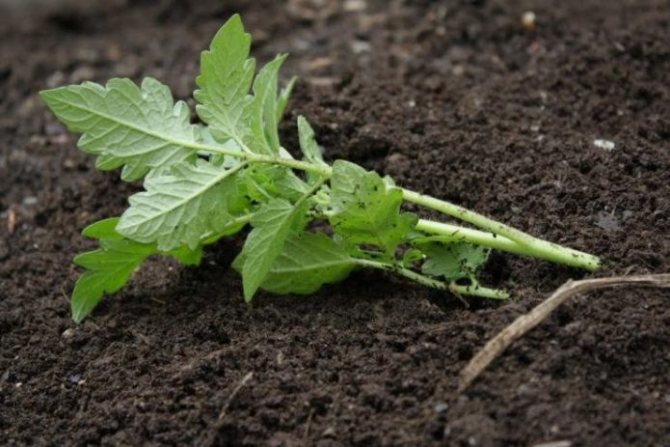

Overgrown seedlings are planted obliquely, over time it will easily rise
Tomato bush One hundred pounds are led into one or two stalks, all the extra stepsons are systematically broken out. In addition to tying the stems, it is advisable to tie up the largest fruits separately, or, if it is easier, substitute supports for them. The leaves are cut off as they turn yellow, and when the tomatoes turn red, the leaves that cover them from the sun are removed.
Watering and fertilizing modes are usual. Before the tomatoes ripen, the ground is kept constantly in a slightly moist state, then watering is reduced: a little drying is beneficial for the fruits, increases their sugar content. Tomato is fed one hundred pounds according to the traditional scheme, three times a summer.
Further care
The ratio of sugars and acids in a tomato body is decisive for taste and aftertaste. You will not feel the characteristic sourness in the “One Hundred Pounds” variety. The taste buds of the tongue perceive the fruit as something pleasant, refined and desirable to repeat.
The dry matter content makes the fruit fleshy. The processed products at the exit have a thick and rich consistency with high taste characteristics.
The yield of marketable raw materials from this variety is always very high, which cannot but please both vegetable growers and housewives.
Detailed description of the variety
Tomato, which grows in almost all regions where it is possible to engage in agriculture, with proper care and formation, rewards a good harvest.
Description of the plant
Powerful bushes of indeterminate tomato require attachment to a support, since they exceed 2 m in height, they have unlimited growth, so the top must be pinched off. The leaves are of the usual shape, dark green in color, the bushes do not thicken very much.
On one brush, about 7 fruits are formed, which ripen and sweets are gathered even at home, if plucked unripe.
Description of vegetables
Tomatoes One hundred pounds have a decent size, weighing from 200 to 350 grams. The mass of fruits that are tied on the upper branches is less than 150 g, such specimens are preserved as a whole. The variety surprises not with its bright color of the skin and pulp, but with its original shape. Tomatoes are similar to a pear, and ribs begin right from the stalk. Summer residents love tomato:
- for a rich taste;
- pleasant aroma;
- the presence of sourness.
Thin but dense skin prevents the tomatoes from cracking and damage during transportation. The fleshy pulp, rich in lycopene, sugars and carotene, contains almost no seeds.
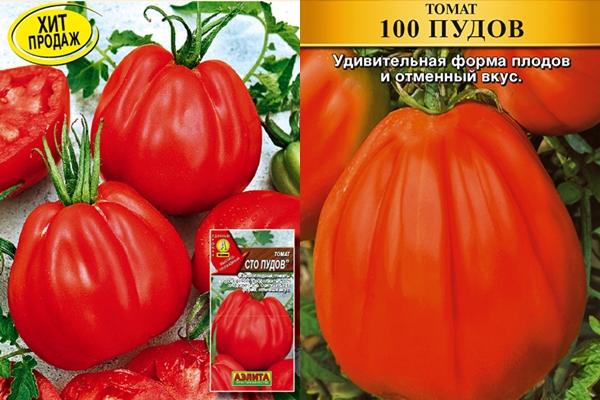

Yield
Tomato fruits ripen in medium terms, pluck them 110-115 days after the sprouts emerge. In the southern regions, tomato seeds are sown one hundred poods directly to the garden; in the central regions, seedlings are first grown. Up to a bucket of fruit is harvested from one bush.
Disease resistance
Subject to agricultural technology, tomatoes are rarely affected by a bacterial infection, since they are immune to the effects of harmful microorganisms, but this does not mean that prevention can be omitted. Before planting in the garden, the soil must be treated with potassium permanganate, and then be sure to:
- Loosen the ground.
- Pull up the weeds.
- Hilling bushes.
- Remove excess leaves.
See also
Description of the Staroselsky tomato and cultivation techniques
To read
If tomatoes are grown in a greenhouse, regular ventilation and good ventilation are necessary. Spraying plants with Bordeaux liquid or potassium permanganate solution reduces the risk of fungal activation.
Advantages and disadvantages of the variety
The shoots of a tall tomato need to be tied up, properly shaped, which takes time for gardeners, but tomatoes delight with a harvest in difficult climatic conditions. The advantages of the variety include:
- rapid maturation;
- great fruit taste;
- original appearance.
Tomatoes are great for making juice, decorating salads. Bushes are rarely affected by diseases, which also attracts summer residents and gardeners.
Features of growing and storage
The variety is cultivated only through seedlings, sowing 65-70 days before transplanting the seedlings to the garden bed.
The planting pattern is three bushes per square meter. Vines form mainly in one stem. Experienced gardeners can grow this tomato in two or even three stems, be sure to pinch the tops 3 weeks before the end of the season.
Tomatoes, despite their size, are well stored and transported. Longitudinal, well-defined ribs give the fruit cushioning properties.
The crop is transported in boxes in one layer. When ripe, tomatoes will stay in the refrigerator for about a week. Plucked in technical or milky ripeness, they ripen well in a warm room without losing their taste and attractive appearance.
How to store crops and use in cooking
The dense skin makes the Hundred Pounds variety transportable. Tomatoes can be transported without problems, they tolerate the road well. For this, entrepreneurs appreciate him.
There is one trick you can apply to extend the shelf life of an already harvested crop. Tomatoes must be picked very slightly unripe - then they will ripen for a few more days and will spoil later.
This variety is especially good for culinary specialists - it is completely versatile. Fresh tomatoes are good as an independent snack or as part of salads, in blanks - they are suitable for juice, ketchup, tomato paste, sauce in other dishes. The problem can arise only with conservation - the variety is large and many fruits simply do not physically fit into the jars.




